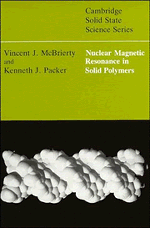Book contents
- Frontmatter
- Contents
- Preface
- Acknowledgements
- Glossary of terms
- 1 The NMR of solid polymers: an overview
- 2 Basic concepts in NMR
- 3 Nuclear spin interactions
- 4 Experimental methods
- 5 Structure and motion in solid polymers
- 6 Structural heterogeneity in polymers
- 7 Oriented polymers
- 8 Selected topics
- Appendix 1 Data on common polymers
- Appendix 2 The rotation operator
- Appendix 3 Rotation of tensors between coordinate frames
- Appendix 4 Spatial distribution of structural units in a polymer
- Appendix 5 The internal Hamiltonian
- Appendix 6 Spectral lineshapes
- Appendix 7 Analysis of spinning sidebands
- Bibliography
- References
- Author index
- Subject index
8 - Selected topics
Published online by Cambridge University Press: 19 October 2009
- Frontmatter
- Contents
- Preface
- Acknowledgements
- Glossary of terms
- 1 The NMR of solid polymers: an overview
- 2 Basic concepts in NMR
- 3 Nuclear spin interactions
- 4 Experimental methods
- 5 Structure and motion in solid polymers
- 6 Structural heterogeneity in polymers
- 7 Oriented polymers
- 8 Selected topics
- Appendix 1 Data on common polymers
- Appendix 2 The rotation operator
- Appendix 3 Rotation of tensors between coordinate frames
- Appendix 4 Spatial distribution of structural units in a polymer
- Appendix 5 The internal Hamiltonian
- Appendix 6 Spectral lineshapes
- Appendix 7 Analysis of spinning sidebands
- Bibliography
- References
- Author index
- Subject index
Summary
In this chapter, a number of examples are chosen to illustrate further the diversity of application of NMR in the field of solid polymers. The treatment is necessarily cursory since each topic forms a major area of research in its own right. The particular selection also serves to illustrate the point that useful information can be obtained with relatively unsophisticated and routine NMR procedures without the need for absolute recourse to state-of-the-art facilities.
Network systems
This discussion on network and interpenetrating network (IPN) systems affords the opportunity to comment further on the molecular motional regime between the extremes of solid and liquid behaviour, of which the interfacial effects discussed in Section 6.3 are examples. Generally, topological constraints such as entanglements and cross links induce significant deviations from liquid-like behaviour which are usually reflected in complex NMR relaxation decay (Kimmich, 1988). Motion is inevitably highly anisotropic and this leads to a residual dipolar coupling that typically defines the shape of the transverse relaxation function. Conversely, the shape of the function contains valuable information on the underlying complex motions. These effects were implicit in early measurements of the influence of molecular weight on NMR relaxation (McCall et al., 1962) where the Rouse-like dynamics for low-molecular-weight polymers developed into the more complex behaviour of entangled chains as the molecular weight increased.
- Type
- Chapter
- Information
- Nuclear Magnetic Resonance in Solid Polymers , pp. 269 - 296Publisher: Cambridge University PressPrint publication year: 1993



